Nestled on the St. Lawrence River in Eastern Ontario, Upper Canada Village represents a busy community in the 1860’s. We visit it every few years with a whole group of homeschoolers, and each year something else stands out. One year it was the ripe pears falling from the trees, one year it was being handed a broom by the farmer’s wife to help corral the escaped piglets, and this year it was the fascinating tidbits shared by the costumed interpreters. (Unfortunately, I had camera troubles, and did not get good pictures of the people mentioned below.)
Cheese Factory: While systematically stirring a 900 gallon of vaguely orange milk, an old cheese maker explained that cheddar cheese was dyed orange so that the British customers would be able to tell if it was North American or English cheddar. The dye, annatto, is still used in cheddar cheese, butter, margarine, and even frozen French fries. (That’s more information than I could have gotten from Wikipedia.)
Gardens: In our home garden we have a white-flowered weed, American nightshade, that has very poisonous purple berries. I was shocked to find a larger version cultivated in the large farm garden. Garden huckleberry, one interpreter identified it for me, and yes, it is poisonous. Garden huckleberries need to be soaked in baking soda for a long time before they are safe, but then they make good pies and jams. (Note that other sources say it can be eaten straight from the bush, and that the baking soda is just to remove bitterness. I wouldn’t bet my life on it.)
Physician’s House: According to the physician’s servant, if a loved one died in the 1860’s, the corpse would need to be guarded for several days, both before and after burial. Medical schools needed cadavers and body snatchers would steal them from cemeteries or where ever else they could get them.
Most married physicians hired a helper for their wife. After all, the doctor himself was on call 24/7, and if his wife was called to the door for a medical emergency when he was away, someone was needed to keep the children safe and to watch the fire. Once the children were safely in bed and the cooking was finished for the day, the doctor’s wife could manage on her own.
Tin Smith’s Shop: Tin, a precious metal because it is rare and non-toxic, was the basis for the Bronze Age. The tinsmith explained to us that Britain’s tin mines provided a great resource for trade from ancient times to the present. Because tin was needed to form bronze, countries with tin also were able to produce weapons. Now tin is used in cosmetics, toothpastes, and, of course, to line tin cans, but in the 1860’s it was the most affordable substance for cups, plates, and more.
Dressmaker: A party dress could be made suitable for more modest wear by wearing a chemisette underneath it to provide a high collar. Of course, the arms would need to be covered too, so separate sleeves worn under the short party dress sleeves were tied to the top of the arms with drawstrings.
Because hangers had not been invented, all clothing was stored flat. For long-term storage, pleats and ruffles were often removed from party clothes waistbands so the garment would not wear out due to pleats being pressed in storage.
If you wanted a seamstress to sew your clothing, you had to provide the fabric, the trim, and the buttons. The seamstress displayed a strip of simple ribbon, folded and stitched into elaborate trim. Apparently the seamstresses in Upper Canada used to charge half the cost of the fabric to sew a dress. Obviously, they preferred sewing silks to sewing calico, and most women sewed their own clothing.
General Store: A general store would carry everything you needed. “If we don’t sell it, you don’t need it.” So, what was needed? Well, arsenic to kill critters that would eat food stores meant for the family or their livestock. And laudanum for medicine. And calico, crockery, and so much more.
Printer’s Shop: An enthusiastic dimpled printer with ink stains all over her sleeves explained fonts, upper and lower case. She discussed linotype, and pointed out that advertisement headlines and details were set by hand into the 1970’s! Her posters were on display all over the village, advertising medicine, fairs, and entertainment, and Miss 15 had a wonderful time reading them. You can see some of the posters in the cheese photo above.
Where doors needed to be closed (at the cheese maker to keep the flies out, at the farm house’s yard to keep the piglets out) weights on strings were used to pull it closed. So much simple technology is fading away, and I’m grateful to living museums like Upper Canada Village for preserving it.
We spent the entire day at Upper Canada Village, wandering happily from house to house, from artisan to artisan. We took a horse-drawn tow scow along a small canal dug alongside the St. Lawrence; we relaxed on a horse-drawn wagon. For lunch, we ate in an enclosed memorial park for Protestant pioneers, and the gulls ate with us. It was an almost-perfect day, and we are so grateful that we were able to enjoy such a field trip!
If you’re ever near Eastern Ontario, I highly recommend a visit to Upper Canada Village. After half a dozen full-day visits, it’s still one of our favorite outings.

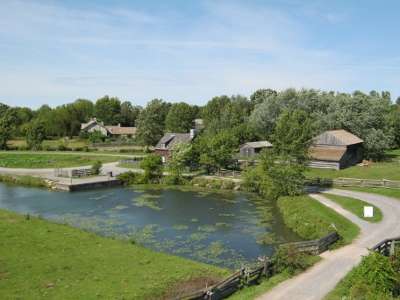

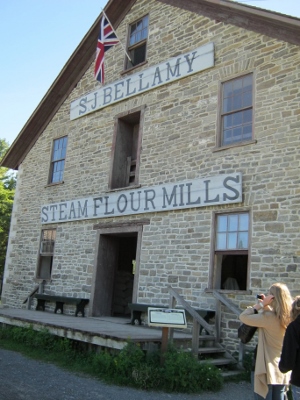
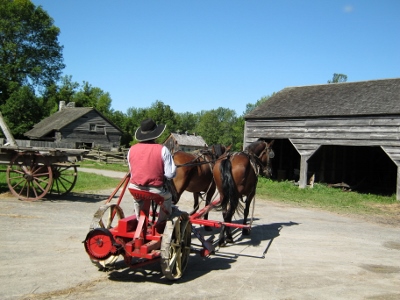
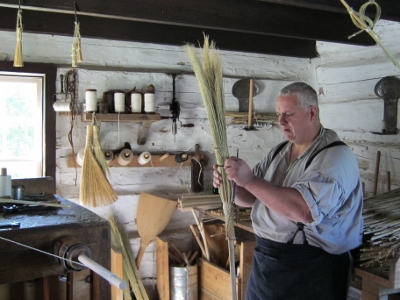
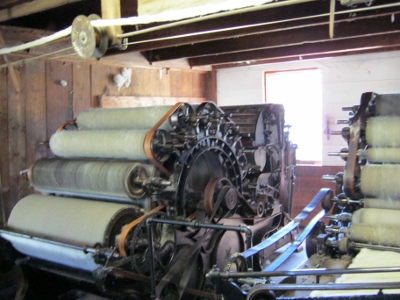
Sounds like such an interesting place. And that part about having to guard the bodies, ugh. Glad you had such a good visit.